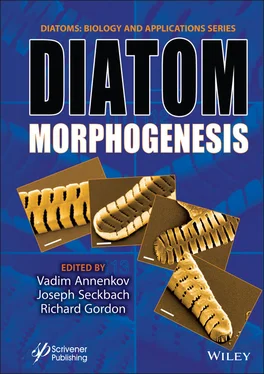Diatom Morphogenesis
Здесь есть возможность читать онлайн «Diatom Morphogenesis» — ознакомительный отрывок электронной книги совершенно бесплатно, а после прочтения отрывка купить полную версию. В некоторых случаях можно слушать аудио, скачать через торрент в формате fb2 и присутствует краткое содержание. Жанр: unrecognised, на английском языке. Описание произведения, (предисловие) а так же отзывы посетителей доступны на портале библиотеки ЛибКат.
- Название:Diatom Morphogenesis
- Автор:
- Жанр:
- Год:неизвестен
- ISBN:нет данных
- Рейтинг книги:5 / 5. Голосов: 1
-
Избранное:Добавить в избранное
- Отзывы:
-
Ваша оценка:
- 100
- 1
- 2
- 3
- 4
- 5
Diatom Morphogenesis: краткое содержание, описание и аннотация
Предлагаем к чтению аннотацию, описание, краткое содержание или предисловие (зависит от того, что написал сам автор книги «Diatom Morphogenesis»). Если вы не нашли необходимую информацию о книге — напишите в комментариях, мы постараемся отыскать её.
A unique book presenting the range of silica structures formed by diatoms, theories and hypotheses of how they are made, and applications to nanotechnology by use or imitation of diatom morphogenesis.
Audience
Diatom Morphogenesis — читать онлайн ознакомительный отрывок
Ниже представлен текст книги, разбитый по страницам. Система сохранения места последней прочитанной страницы, позволяет с удобством читать онлайн бесплатно книгу «Diatom Morphogenesis», без необходимости каждый раз заново искать на чём Вы остановились. Поставьте закладку, и сможете в любой момент перейти на страницу, на которой закончили чтение.
Интервал:
Закладка:
Nano-, micro-, or macro-scale dependent symmetry may be evident as individual or groups of structural features that may not have the same symmetry at the same time (Figure 2.3). Concomitantly, these different kinds of symmetry are measurable implicitly at multiple scales. By isolating sections of the valve face in terms of micro or nanostructure, each kind of symmetry can be measured. Scale dependency occurs if a valve formation sequence is not monotonic or linear. For example, centric diatom symmetry in Cyclotella meneghiniana may be an example of scale dependency (Figure 2.19). In some cases, scale symmetry as scale invariance may be present (Figure 2.3k). Pattern repetition at multiple scales and fractal scaling may be determined by testing for the Hausdorff dimension [2.29].
2.4.2 Valve Formation and Stability
We modeled our diatom morphogenetic valve formation system as dynamical and in equilibrium in order to test for stability behavior as it is associated to symmetry. Uncanny symmetry as a measure was useful in determining the degree of stability in valve formation. We determined that valve formation simulation proceeded primarily as deterministic chaotic instability mixed with lesser periods of stability. While instability may look like randomness, we found that for our simulation of valve morphogenesis, accretionary behavior is essentially chaotic. Valve formation PDF depicted a gamma distribution with a stretched exponential tail (Figure 2.20), potentially indicating intermittency in this dynamical system [2.115], provided that as time approaches infinity, the Lyapunov exponent is equal to zero [2.74].
Stability analysis in the form of Lyapunov systems provided a way to assess the sources of instability with regard to valve formation in diatom morphogenesis. Finding a deterministic chaotic component is noteworthy because the assumption is that only random behavior dictates instability in developmental systems [2.54], or that if chaos is present, it cannot be quantified separately from randomness [2.53]. Our results indicate that the behavior of instability varies chaotically and randomly throughout the valve formation process; however, less symmetric forms have the highest instabilities. In spite of the presence of chaotic and random instabilities, valve formation overall is a regular, stable process when considering the end product. The chaotic component of instability may be indicative of multi-scalability of symmetry during valve formation. Fluctuations of chaotic and random instability may be embedded in the valve formation system so that at times, scale symmetry as well as scale-dependent symmetries may be present.
Diatom valve formation in morphogenesis may be viewed as exhibiting different dynamical system qualities. Some elements of valve formation may be dissipative at equilibrium. Other elements may exhibit a reactive-diffusive, non-equilibrium state. Self-assembly at the molecular level may induce periodic micro- and nanoscale pore assemblies that can be modified via nanoparticles in a prescribed way in diatoms [2.165]. Silica deposition may exhibit phase separation at the chemical level of valve formation [2.138] leading to pore formation [2.154]. Elastic instability may induce buckling [2.95] as a phenomenon in diatoms during morphogenesis [2.52] in contrast to Turing instabilities via reaction-diffusion [2.91, 2.99]. Buckling may be characterized by Lyapunov exponents to determine degree of chaotically unstable behavior [2.141].
Valve formation as a dynamical system has aspects of regularity as well. Cross-costae formation exhibits a regularly spaced homogeneous growth pattern, with initiation of the valve formation process starting with a central organizing structure [2.154]. The dynamic growth of a diatom valve is spatially controlled, and sequential deposition contributing to the height of silica on the valve surface contributes to species-specific pattern formation [2.154]. Given constraints in the process, at the valve micro-scale surface, chaotic or random instability may be present, while at the nano-scale level, hexagonal or round pores with varying patterns of cribra within areolae pores may be in a regular periodic stabilizing pattern. Morphometric noise of multiple traits has weak control over pore shape and size. Development of a morphological character such as a pore is affected by inhibitors in contrast to the spatial arrangement of pores [2.154]. With further study, parsing the relation between unstable and stable states at multiple scales may be useful in understanding symmetry breaking [2.41, 2.102] during valve morphogenesis.
2.4.3 Symmetry, Stability and Diatom Morphogenesis
Diatoms and valve morphogenesis are a combination of static structure formation at specific time junctures and a dynamic progression to the formation of the vegetative cell. As static structures, diatoms have high symmetry, termed uncanny symmetry. As selforganizing siliceous structures, they are some of the most stable static structures. Entropy as an ensemble measure [2.84] is instrumental in measuring of silica-deposited dynamics during valve formation that lead to the various regularly created geometric patterns defining species-specific valve surfaces.
The dynamical process from a more to less chaotic unstable state may be a characterization of self-organization. In the valve formation process, self-organization is the recovery from a chaotic unstable state, even though the chaotic state could be construed to be “normal.” Symmetry is a reflection of these states. In contrast, abnormally developed valves could be construed to be in a higher “abnormal” chaotic state, and stress during valve formation is evidenced by the resultant vegetative cell and its increasingly asymmetry state. Self-organization as the appearance of new structures may be a transition from a more chaotic, unordered to less chaotic, more ordered symmetry state, or vice versa in the case of a final abnormal symmetry state. In this way, equilibrium states during non-linear dissipative fluctuations in a dynamical system may end up being the most chaotic states [2.71].
The picture that symmetry and its relation to stability exhibits during morphogenesis is not straight-forward. In fact, no quantitative generalized overall framework for evolutionary dynamics, including stability of structural inheritance or structural integrity during reproduction for changing environmental conditions, exists with respect to diatom morphogenesis [2.131]. From our study, we give a speculative understanding and interpretation of our results on symmetry and stability as they pertain to the three major steps of centric diatom morphogenesis [2.126].

Figure 2.25Average sequence of 24 simulated valve formation steps of symmetry for eight centric diatom taxa. Symmetry increases exponentially from the annulus to the completed valve.
Overall, symmetry increased over the valve formation simulation with highest symmetry at the finished vegetative valve (Figure 2.19). The basal layer that forms from silica deposition horizontally during the first major step of diatom valve morphogenesis, starting with the annulus, is roughly covered by the first 8 of 24 “stages” of simulation (Figure 2.18). Symmetry with the lowest values occurring at approximately the same value (Figure 2.25). For roughly “stages” 9–16 representing the second major step, vertical silica deposition is represented by the changing luminosity of pixels in the central area of the images as the indication of the formation of rays and areolae emerges (Figure 2.18). Symmetry changes become more evident, going from low to higher symmetry, yet still within a small range (Figure 2.25). For the final major step, horizontal silica deposition is represented by even more changes in pixel luminosity over the valve face in “stages” 17 to 24 where indications of the formation of cribra going toward the valve margin is present (Figure 2.18). Symmetry changes are highest in these “stages”, representing completion of silica deposition of the valve (Figure 2.25). The valve forms present during the three major valve formation steps may be viewed as symmetries functioning as silica depositional ensembles changing in direction and magnitude (horizontally to vertically to horizontally again) on the valve face. This dynamical system operates at equilibrium with exponentially changing symmetry occurring via chaotic instability during valve formation.
Читать дальшеИнтервал:
Закладка:
Похожие книги на «Diatom Morphogenesis»
Представляем Вашему вниманию похожие книги на «Diatom Morphogenesis» списком для выбора. Мы отобрали схожую по названию и смыслу литературу в надежде предоставить читателям больше вариантов отыскать новые, интересные, ещё непрочитанные произведения.
Обсуждение, отзывы о книге «Diatom Morphogenesis» и просто собственные мнения читателей. Оставьте ваши комментарии, напишите, что Вы думаете о произведении, его смысле или главных героях. Укажите что конкретно понравилось, а что нет, и почему Вы так считаете.












